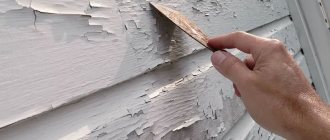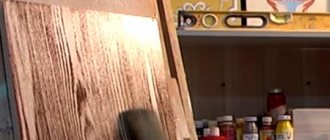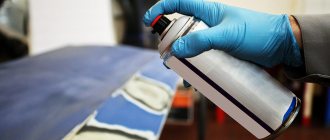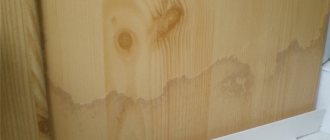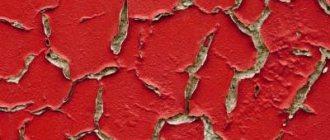Household repair No. 1
Choose reliable craftsmen without intermediaries and save up to 40%!
- Fill out the application
- Receive offers with prices from masters
- Select performers by price and reviews
Post a task and find out prices
- Minor household repairs
- Renovation of apartments
- Articles
- Renovation of apartments
It happens that you need to repaint some metal product in your house, garage, or country house. Naturally, you shouldn’t do this over old paint. It is necessary to remove the peeling coating from the metal, otherwise the new layer will begin to peel off. To remove old paint from metal, there are many different methods: professional and amateur. To remove the coating you will need:
- Special liquid (removal)
- Putty knife
- Thermal gun
- Grinder
- Mineral based kerosene.
Removing old paint from metal
When you need to renew a metal coating that has many layers of paint, you should be prepared for a labor-intensive process. By the way, removing paint can be difficult, because manufacturers try to make their product wear-resistant and durable. Old paint can be removed in the following ways:
- Mechanical
- Thermal
- Chemical.
As practice shows, it is most convenient to remove paint from metal with a special liquid. To understand why this is so, it is necessary to study each of the above paint removal methods.
If you have hand or power tools in your home, you can use them to remove old paint from metal. By the way, consumers often choose hand tools because they are less expensive and easy to use. Although, when it comes to the need to remove paint from metal, wire brushes are not the best option. It is more rational to use a grinder for this, which uses a wire brush as an attachment. A drill with a metal brush installed in a chuck can also be used. However, this is a rather inconvenient method.
To remove the old paint surface, you can also try the thermal method. In this case, the coating heats up to such a temperature that the paint begins to peel off. Then it is removed from the metal using a spatula. Metal products do not lend themselves well to thermal processing. Such a surface quickly releases the heat it receives, so the paint does not have time to melt. The solution is to use a blowtorch to heat the metal surface, although this option is not suitable for some types of metals.
Metal removal
Special paint remover is easy to purchase. Such products are produced by many companies and firms. In particular, the following washes can be found on the market:
- Kompozit SP-6
- Abro PR-600
- Body 700
- B-52
- BOSNY
- Prestige.
Each liquid for cleaning metal from paint/varnish has its own specifics, so before use it is important to read the manufacturer’s instructions. Paint remover can be of different consistencies:
- Gel and liquid
- Dry powder
- Aerosol.
Although the hardest thing is to decide not on the type of wash, but on its manufacturer. According to consumer reviews, domestic products and foreign products, “BODY”, perform best.
Washing technology
The process of using a special paint remover is extremely simple. To remove paintwork from a metal product, you need to apply the substance and leave it for a certain time (about 15-30 minutes). The expiration date of the washing substance is indicated on the packaging. By the way, there are also compounds that begin to soften the coating after 36 hours. Previously, it makes no sense to treat the surface with a spatula, since the remover will not yet take effect.
Some people find that the gel is more convenient to use because it can be spread evenly. After the chemical reaction is complete, the enamel swells and begins to peel off. It is necessary to carefully go through the sander, sandpaper, spatula and remove the paint. In any case, you should work carefully so as not to spoil the base. When the metal structure is cleaned, it must be coated with an anti-corrosion substance. Now you can start choosing new paint to refresh the metal surface.
The process of removing paint from metal is quite long and painstaking: you need to get rid of the old paint and varnish coating and at the same time maintain the integrity of the product. This requires time and practical skills. If there are none, it is better to contact professional specialists. You can find experienced craftsmen who can help remove old paint from metal and other surfaces on the Yudu recruitment service.
We recommend
Removing old paint DOCKER S4 Professional Purpose. Fast action (4-8 min.) for all types of paint and varnish coatings. Effectively removes any water-dispersion paints (interior, facade), as well as oil paints (MA-21, etc.), alkyd enamels (PF-115, PF-133, PF-266, primer-enamel 3 in 1, GF -021, etc.), acrylic bases. Excellent for automotive enamels. Gel. Thanks to its gel-like form, it is easy to apply to vertical surfaces. Does not contain acid.
More details
DOCKER WOOD - Industrial paint remover from wood. Effectively removes paint and varnish coatings from wood. A special additive allows you to preserve the structure of the wood without damaging the surface of the wood. More details
How and with what to clean dried stains from doors after repairs
One of the most common problems after renovation is foam that has dried on the door. It is quite difficult to clean it, since the substance quickly sticks to the surface. How and how to remove polyurethane foam without damaging the door?
Design Features
Methods for cleaning the door from “installation” and traces of whitewash depend on the material from which the structure is made. Doors can be:
- wooden,
- made of MDF,
- plastic,
- metal,
- glass.
The most commonly used materials for doors are wood or MDF. There are no particular difficulties in cleaning wooden products. But MDF structures can have different types of coating: paint, film, veneer, laminate, etc. Doors with a veneered surface require especially careful care.
Some coatings, for example varnished and painted ones, can deteriorate due to the use of solvents, so you need to be careful when resorting to chemicals.
Methods for cleaning polyurethane foam
Polyurethane foam dries quickly, so the sooner work begins, the greater the chance of cleaning the door without leaving a defect on it. In order to wash fresh polyurethane foam, a special remover or solvent is used.
It is much more difficult to clean dried traces of foam. You can do this as follows:
- Trim the remaining foam as close to the door covering as possible.
- Cover it with solvent, special remover or vinegar. When the foam gets wet, try cleaning the stains using a scraper or a stiff sponge.
- For best results, use a squeegee that is harder than foam but softer than the surface of the door. Clean away traces of foam until you get rid of them completely.
How to clean traces of whitewash
Another pressing problem after renovation is cleaning whitewash stains, which result in cloudy stains appearing on surfaces. If the door is glass, you can wash off drops of whitewash with a regular glass spray. In order to remove dirt from a metal or wooden structure, you need to “arm yourself” with a soft cloth and a bucket of warm water. This process is slow, but effective - stains are completely wiped off the coating.
How to remove grease stains
The process of installing new doors is not complete without the use of technical oil to lubricate door hinges. After which greasy spots may appear on the surface. The most effective “weapon” for combating such pollution is starch. Both dry starch and regular raw potatoes will do. Cut the vegetable into 2 parts and rub the cut side onto the greasy stain so that the potato juice is absorbed.
Another alternative way to clean greasy marks on the door is baby powder, which contains talc.
You can also use regular soap solution. But be careful with MDF coatings, which can deteriorate from too much moisture.
Acetic acid is also a good helper in the fight against greasy stains. The greatest effect can be achieved if you apply a mixture of clay and vinegar to the stain. Afterwards, all that remains is to clean the mixture with a slightly damp cloth.
How to clean paint
The most effective and popular solution for removing paint stains is solvent. However, you should not use it to clean dirt from MDF - it is better to apply alcohol to the surface, and then carefully remove the remaining paint with a blade. Even greater difficulties arise when washing stains from frosted glass.
If it is sandblasting, then you can use a regular solvent. To clean the glossy surface from dirt, use a special scraper. The least problems arise with removing traces of water-based paint, which can be easily washed off with plain water.
How to wash primer
Many difficulties arise when washing the primer from the door leaf, since this composition dries quickly and immediately eats into the coating. Methods for removing primer stains are as follows:
- a cloth dampened with water (for fresh dirt),
- vinegar solution,
- soda,
- glass or tile cleaner,
- ammonia.
In order to soften dried stains, foam or fresh primer is also used.
Features of removing different types of paint
- Oily. For paint applied in a thin layer, any cleaner, such as acetone, will do. The thick layer is removed mechanically. In difficult cases, burning is used.
- Acrylic. Acrylic-based paint can be removed with solvents or removers. To improve the result, the metal must first be cleaned. If the acrylic composition is applied to a moisture-resistant base, it can be removed with a hot soapy solution mixed with a small amount of alcohol.
- Powder. The best method is burning or using a sandblaster. If this method cannot be used, chemical agents will help remove the powder paint. means – Fail-4, Remover. After chemical treatment, the metal must be polished.
- Aerosol. The dye sprayed from the can is removed with sandpaper or a metal brush. After mechanical treatment, the metal is wiped with a solvent.
- Latex. Do not clean mechanically or thermally if the layer is applied to a surface coated with polymer protection. The best option is chemical.
How to clean polyurethane foam from a metal door - means and methods of action
Reasons for foam getting on the door surface
The next step after installing the door structure is to seal the doorway and voids. The work is carried out using polyurethane foam (polyurethane sealant), which is supplied in the form of pressure cylinders. The substance has good sealing properties and is easy to apply, which has made it popular.
However, during use, unforeseen situations occur when the composition gets on the surface of the door, which can compromise the integrity of the decorative coating. This happens for several reasons:
- due to little experience, it was not possible to accurately determine the required amount of the injected mixture. When expanding, the volume of foam turned out to be larger than the cavity being sealed and the excess began to protrude from the gap, leaving marks on the door;
- using cheap non-professional series cylinders with a plastic tube. This mechanism does not allow you to control the rate of foam release and when the valve is released, the composition continues to be released. If you move your hand carelessly, the clump comes off the tube and settles on the door leaf in the form of splashes. Also, when the foam runs out, it is supplied in jerks along with the remaining gas. At this moment, the spray flies out at high speed and scatters, settling on nearby surfaces.
How quickly does polyurethane foam harden?
The peculiarity of polyurethane is its ability to polymerize to a solid state within 7–12 hours from the moment of spraying. If the foam has time to harden, it becomes impossible to dissolve it, whereas a fresh mixture can still be dealt with.
How to remove polyurethane foam from a metal door: determine the type of coating
Polyurethane foam has high adhesive ability to any surface and, after polymerization, becomes resistant to chemicals. The ability of polyurethane to perfectly seal cracks becomes an obstacle when cleaning.
The choice of product and method of action depends on the type of coating on the front door. Most often you have to deal with:
- with a layer of paint or varnish;
- metal or chrome surface;
- powder coating or enamel;
- with veneer finishing;
- acrylic or plastic coating.
An annoying mistake can be noticed immediately or discovered after some time. Accordingly, two types of pollution are considered.
Removing fresh foam from doors
Success in the fight against foam fragments largely depends on efficiency. You need to have time to remove it while the polymerization process is underway and not allow the substance to dry out. Using a wet rag and trying to clean the door from dirt is strictly prohibited; under the influence of moisture, the foam will instantly harden and it will be much more difficult to remove it.
If the substance gets on uncoated metal, then just wait until it dries and carefully wipe off the stain. If foam gets on a layer of nitrocellulose-based varnish, you will have to deal with restoration, because upon contact, the varnish finish will instantly collapse. If we are talking about an alkyd and polyurethane-based coating, then there is hope of preserving it. The lump of mixture should be lightly removed without touching the surface. Before drying, wash the remaining thin layer with a rag soaked in acetone, which dissolves the fresh mounting mixture well. It no longer affects old stains. Acetone is also useful for removing foam from a structural laminated surface.
A good way to remove non-dried foam from a metal door is a special remover for cleaning the gun. It is more effective than regular acetone.
Fighting dried polyurethane foam
Removing hardened polyurethane is based on dissolving polymer chains. For these purposes, solvents and special removers are used. At the same time, we should not forget that they equally affect the decorative coating of a metal door.
First you need to try to remove the frozen mixture mechanically. After removing the top, an adhering layer with a dense structure will remain. It is torn off in one piece, and the remains are cleaned off with the hard side of a foam sponge or a school eraser.
If the frozen bubble does not give in, then you need to influence the foam to reduce adhesion to the surface. This is done using substances with a similar level of adhesion. An effective remedy that will not harm the varnish is a gel solution or sunflower oil. It is applied to the contaminated area and left to act for several hours, then the adhered crust is removed. White spirit and Dimexide, which is sold in pharmacies, make polyurethane foam soft and pliable. In addition, Dimexide does not damage varnished and plastic surfaces. But white spirit, after prolonged contact with the varnish, penetrates its structure and leaves cloudy traces on the surface.
If there is minor contamination on the outside door, you can wait until the polyurethane naturally degrades under the influence of ultraviolet rays.
Choosing a product: how to clean polyurethane foam from a door
There are a sufficient number of cleaners that can cope with foam. It is recommended to select them from the same brand as the bottle with the mixture. So, how to remove polyurethane foam from an iron door without damaging the surface:
solvent 646 - composition for diluting paints, nitrocellulose paints and varnishes;
acetone is a colorless liquid with a characteristic pungent odor;
Cosmofen5 is a substance known to craftsmen when installing windows. It is a polyvinyl chloride polish with strong solvent properties;
Cosmofen10 and Cosmofen 20 - cleaner for window profiles from fresh and old traces of foam;
IsofoamR 621 is a universal product for cleaning and washing a Russian-made mounting gun;
Macroflex is a detergent that can soften foam;
white spirit is a solvent for paint and varnish products;
PENOSIL Premium Cured PU-Foam Remover is a good solvent for hardened sealant;
any solvent for automobile paints or a means for cleaning foam bottles.
From folk and improvised home remedies you can use:
nail polish remover containing acetone;
vegetable oil slightly heated to 50–60°;
pharmaceutical product Dimexil;
soda is a finely abrasive product with a gentle effect on the surface. It is enough to rub the dirt to remove the adhering foam;
potatoes and talc - will cope with traces of foam on veneer. Simply rub the stain and wait until it dries, then remove the residue with a napkin and polish with talcum powder.
What compounds are prohibited from being used?
For an uncoated metal door there are no restrictions in choosing a cleaning product. For products with decorative finishing, you cannot use aggressive liquids that can damage the structure. Do not use acetone or solvent to clean plastic coverings. Dark stains remain on wooden and veneer doors after applying oil. Trying to wash off the polyurethane foam with a solution of soap or powder is also not worth it.
Precautionary measures
Polyurethane foam refers to substances that can penetrate deep layers of base material and interact at the molecular level. This property is the reason for the difficulties encountered when removing the mixture. In order to prevent unpleasant moments, before starting work, it is recommended to cover the surface of the door leaf and frame with a protective film and secure it with tape.
General scheme for surface cleaning and preparation for painting
In life, all 3 cleaning methods are used, since one is often ineffective. To remove paint from doors, it is removed from the hinges, laid on a horizontal surface, and handles and locks are unscrewed. To bring the door into proper shape, before painting, remove the old coating using any of the following methods, sand the surface, removing small defects, chips, repair scratches, and more serious defects using putty.
In order to efficiently remove old paint from doors, prepare materials, tools and protective equipment:
- solvent;
- brushes;
- spatulas;
- gloves and safety glasses;
- Sander;
- wood putty;
- skin of different grain sizes.
Protect your hands with rubber gloves and your eyes with glasses, apply the drug with a brush, covering the entire surface of the door.
How to Remove and Renew Old Paint
Before making home renovations, many people are faced with the task of removing old paint. The painted surface has low adhesion to plasters, tile adhesives, and building mixtures, so the new finish may not adhere to the previous coating. The process of removing paint and varnish material (LPM) should be approached with special care so as not to damage the surface being painted. In this article we will look at all the nuances of how to remove old paint from wood and metal surfaces, as well as what you need to consider before applying new material.
How to remove old paint from metal
Before painting a metal structure, rust and old paint should be removed, otherwise the new coating will look unsightly and may quickly peel off. There are three main ways:
- Mechanical — the surface is treated with sandpaper or a wire brush.
- Pros: economical, tools available.
- Cons: long, possible damage to the product.
- Thermal - the surface is heated with a blowtorch until the paint begins to peel off.
- Pros: prompt, efficient.
- Disadvantages: increased fire hazard, unsafe for health.
- Chemical - removing paint using removers and solvents.
- Pros: quick and simple.
- Cons: increased toxicity, environmental unsafety.
The last method is the most appropriate, since there is no risk of damage to the surface, and the work is completed quickly, without unnecessary effort.
How to remove paint from a wooden surface
Most often, professional builders use two main methods to remove paint from wood:
- Thermal — the surface is heated with a hair dryer, then the old coating layer is removed with a spatula.
- Pros: inexpensive, availability of tools.
- Cons: long, can damage the surface.
- Chemical - a special liquid is used to remove old paint from wood. It penetrates deep into the layer of paint or varnish, actively softening it, after which the residue is removed with a spatula.
- Pros: fast, comfortable, economical.
- Cons: toxicity.
The chemical method is more gentle on the surface of the product. It is important to note that solvent for removing old paint is relatively inexpensive, so there is no point in going through the trouble of using other methods.
How to remove old paint from a wooden door
The door must be removed from its hinges and placed in a horizontal position on a flat surface. Before removing old paint from the wooden surface of the door, it is imperative to free the product from fittings and other metal elements. A solvent or special remover must be applied to the old paintwork and left until it swells. The softened paint is scraped off with a spatula or other tool to remove old paint. Residues are removed with sandpaper.
How to remove old paint from window frames
The window frame must be removed from the awnings, after which the glass and fittings must be carefully removed. It is advisable to place the product in a horizontal position.
Most often, paint is removed from windows with a hair dryer. The device is set to a temperature of 250 °C, and then the old coating is removed using a mounting knife and spatula. Instead of a hairdryer, you can use chemicals, such as white spirit.
How to remove old paint from plastic
To remove old paint from plastic, use nail polish remover without acetone or silicate glue. The first remedy is to dissolve and remove old paint from plastic: a cotton pad or paint roller is moistened in liquid, applied to the surface, and then wiped.
Silicate glue is good for eliminating small drops - it is applied to the paint and left until dry. The glue contracts and pulls particles of the old coating along with it. After this, the surface is wiped dry.
How to remove old paint from walls
The most difficult thing to remove is old oil paint from concrete walls. Paintwork can be removed with solvents, but this is not recommended in poorly ventilated areas.
You can remove paint from the walls using a hair dryer. The coating should be heated until it softens, and then removed with a spatula. The main disadvantage of this method is that fumes from varnishes and paints are harmful to health.
The mechanical removal method - using notches with an ax - is convenient for small surfaces. What else can you use to remove old paint? Many people use a hammer drill with a brick crown or a “paint remover” attachment.
FAQ
Can you paint over old paint?
If the old coating has a thin layer and there are no defects in the form of cracks and blisters, then after treatment with sandpaper you can apply a new layer of similar paintwork.
It is recommended to apply acrylic paint on old paint in several layers, and the surface should first be sanded and primed.
Before painting the ceiling with water-based paint over old paint, the surface must be completely cleaned so that it is even and smooth.
Do I need to prime old paint?
Experts recommend priming the old layer to eliminate defects and ensure reliable adhesion to the new coating.
If a primer is not applied to old paint, the painted surface will quickly lose its original appearance. It is advisable to buy primer and paintwork from the same company for a more reliable and durable coating.
Is it possible to apply plaster over old paint?
If the surface was previously covered with oil paint, it must be completely removed, since traces of drying oil significantly reduce adhesion. In other cases, it will be enough to clean and prime the surface.
Additional tips and tricks
You can remove a thin layer of material on a small surface without tools; you just need to rub the surface with a wire brush and sand it with sandpaper. You cannot keep the remover in plastic packaging, the composition corrodes the container. When heated with an open fire, bubbles quickly form on the paint, but the wood often dries out or even burns. Builders do not recommend using chemicals or a hairdryer when there are plastic elements on the door that cannot be removed.
It is not recommended to heat the surface in places where wiring is laid, as this can lead to a short circuit. In some cases, there is no need to clean the coating, and a new one is applied to the old layer. Before this, the coating is sanded, the bumps are smoothed, washed with an alkaline solution, and primed. Both enamel, oil and acrylic paint must be removed if you want to get the effect of translucent wood.
Share link:
How to clean a metal door
How to clean a metal door
How and with what to clean the iron entrance door
How to remove traces of whitewash and lime from an iron door
It is not easy to remove traces of whitewash from the surface of the canvas (especially dried stains). Experts recommend first trying to clean the door with sandpaper. If the spots are large in size, you can use “folk” methods. For example, vinegar diluted in water will help get rid of stains. Approximate proportion: 20 grams of vinegar per liter of water. Vinegar can be replaced with kerosene (in similar proportions). The disadvantage of this method: the specific smell of kerosene, which will disappear after a few hours. This method is not suitable for doors installed inside the building.
Traces of whitewash can be removed with a special cleaning agent, which is sold in household chemicals departments. Probel concentrate, which is odorless, is common in Russia. The product is diluted with water. It also removes lime stains.
| Vinegar | Kerosene | Probel | Sandpaper |
How to clean polyurethane foam from a door
The process of removing polyurethane foam from a steel sheet requires some skills. Cleaning the entrance block from hardened foam is a painstaking process that involves mechanically removing stains. A thick layer of foam is easier to break off. Remove the thin layer of polyurethane foam from the door using a utility knife. If the foam has not dried completely, after repair the chemical is removed with acetone or solvent.
Before starting to work with solvent, you should make sure that it does not spoil the painted surface of the canvas.
How to remove traces of cement and putty
How to get rid of tape marks and paint stains on a door
Masking tape cleaner
How to clean safely?
From the information above, you already understand that there are 3 types of serious pollution:
- Polyurethane foam;
- Dye;
- Grease and dirt.
Features of paintwork
Before cleaning the door leaf, you need to determine what composition was previously applied to the surface and how many layers are present. Paints and varnishes contain chemicals. If the materials are incompatible, the new coating will be uneven, smudges and chips will appear. Having clarified all the points, you can choose the right reagent that will easily remove the old paint.
There are several methods for removing coatings; sometimes you have to combine them with each other. After removing the varnish, you need to go over the surface with sandpaper and cover up the cracks.
How to remove old paint from doors and cover them with new paint as quickly as possible
In matters of repair, one of the important stages is installing a new door or updating an existing one. If you have the financial opportunity, you can replace the old door, but if money is short, then try to bring back the life of the old door structure. Read our article on how to do this.
- Features of removing paint from doors
- Mechanical method of removing paint and varnish material
- Removing old paint thermally
- General instructions for removing paint
- Preparing the door for painting
- Door painting procedure
Chemical method of removing paint
Why repair the door?
Before considering ways to remove paint from doors and choosing the most suitable option, let's think about why waste time and effort.
- Old wooden doors are of good quality. They are made of solid wood, very often oak was used as the material for manufacturing, even if the door is painted.
- Non-standard antique door panels. Old apartments often have antique doors, tall, double-leaf, paneled. You can’t buy these in a store, and making them to order will be expensive.
- The door is beautiful. If you are lucky - and you own a door leaf richly decorated with carvings, it would be blasphemy to throw it in the trash.
- Art object. If you are a creative person who can create a work of decorative and applied art with your own hands, then a wooden door is an excellent field for creativity.
From the points described above, it is clear that there are plenty of reasons for restoration and repair, and you may have your own.
Features of painting garage doors
To protect the structure, the gates are covered with a layer of paint.
Nuances of the work:
- Garage doors are a large surface with hard-to-reach areas. You can paint them with a brush, but it is not very effective. It is better to treat the most difficult areas with this tool, such as:
- fabric joints;
- stiffening rib.
It is not always possible to paint these areas efficiently with a roller. There is a big disadvantage when using a sprayer: a “fog” appears in the work area from small droplets of paint, which will settle on nearby objects, usually on neighboring garages painted in a different color.
We suggest you read: How to clean an aquarium from green deposits
Tip: When choosing a sprayer for painting gates, you should take measures to protect surrounding objects from getting paint.
- Gates are usually made from metal that is subject to corrosion over time. This requires, before painting, to clean the structure from rust and from the remnants of existing paint layers. otherwise, the new layer will not look very nice and is unlikely to last long.
Advice: It is necessary to ensure that there is no rust either inside or outside the structure. Surfaces should be carefully checked and, if necessary, stripped to bare metal. The gate is then degreased with solvent type 646.
- To increase the durability of paint application, the surfaces of the gate must be carefully primed (see Why a primer is needed: technological nuances of finishing work). The primer is selected depending on the type of paint used and the amount that can be spent. How to use a specific primer is indicated by the instructions located on the package. It is better if the primer and paint are from the same manufacturer.
Stages of work
Before removing paintwork using remover:
- The surface is wiped from dust.
- Cover the painted wood evenly with a brush, without going over the same area twice.
- The surface covered with the wash is left for the time indicated on the label, covered with film to obtain a better effect.
- Soon the reagent becomes brown or brown in color, the paint rises, it is removed with a spatula and disposed of.
- If the result is unsatisfactory, the procedure is repeated.
- The cleaned surface is washed with an aqueous solution of vinegar, the door is wiped dry, and left for final drying in a draft.
- After drying the product, they begin to putty, seal small cracks and chips.
- Use fine sandpaper to smooth the surfaces. If you have a grinding machine, this procedure is easier. Level and polish the surface, making movements in one direction to avoid roughness.
- Use a dry rag to remove dust and putty residues.
- The door is ready for painting.
Heat treatment
To clean wood, you can heat it. As a result, the paint material will adhere to the base much worse. Cracks will appear on the coating, and it can be removed using a special tool (spatula, chisel).
When carrying out heat treatment, there are several important points to consider.
- If the coating begins to char instead of peeling off, the cleaning method will have to be changed. In this case, you can use chemicals.
- Goggles and protective gloves must be used. Also, thorough ventilation is required during and after work. When varnish heats up, it can release substances that are hazardous to human health. It is also worth considering that pieces of paint and varnish material may bounce off the base. You should also remember about fire safety.
The work may require special equipment.
Construction hairdryer. Such a device can heat surfaces much more than a conventional household appliance.
Gas or gasoline burner. The price for such devices is quite reasonable
However, it should be borne in mind that you need to work with the burner as carefully as possible, otherwise you can be seriously injured.
Heat treatment has one important advantage - the work is carried out very quickly. However, the varnished base should not be allowed to overheat, otherwise a fire may occur.
You should work using both hands. One needs to hold the device, the second - a spatula, with which you will remove the paintwork.
See below for a master class on removing varnish from a wooden surface.
How to clean safely?
From the information above, you already understand that there are 3 types of serious pollution:
- Polyurethane foam;
- Dye;
- Grease and dirt.
Firstly, getting rid of grease and dirt is much easier than getting rid of foam and paint (you won’t have to use chemicals and harm your health if safety precautions are not followed). Secondly, if you are allergic and have sensitive skin, and just the smell of paint makes your head swim and your vision darkens, call a friend for help, you shouldn’t harm your health.
Cleaning from dirt and grease is carried out taking into account the door coating. For example, if the model is painted with oil paint, then you need to use warm water with alcohol. Pour a liter of water into a bottle and add 5 milliliters of ammonia, then wipe the door. The main rule is not to use detergents with solid particles, as they severely scratch the coating. Because of this, you will have to spend a lot of money on repainting the door.
Use a soft cloth for cleaning. Be sure to dry the door, otherwise the paint will gradually curl and turn yellow.
If on your door there are Russian words with a “deep” meaning, written by young representatives of subcultures, then do not rush to treat the door with acetone. Yes, this is an effective method, but what if you have a delicate wood flooring? This will only worsen the structure of the material. You can only use acetone if you have a thermal spray door coating.
Buy door cleaning products from a specialty store. They are versatile and easy to handle paint. You need to apply the product to the coating and leave it for a certain amount of time until the paint is removed. At the end, the door is wiped with a damp cloth and completely cleared of paint.
The main problem is removing dried polyurethane foam. Precisely dried, since fresh foam can be easily removed with a damp cloth. Here you can object and say that the foam falls off easily when using acetone and other substances that are sold in hardware stores. But remember - all doors are covered with MDF panels or a thick layer of paint. Aggressive chemicals will worsen the condition of the door, but the foam will naturally be removed (but at what cost).
If your door has a powder coating as a coating, then you can remove the foam using steel wool. First, cut off most of it with a knife, then rub the stain. Polish can be used to erase stains that have formed on a model with a wooden coating. It is not recommended to use chlorhexigine and other aggressive drugs, but it is possible - the main thing is to use them locally and in small quantities (if you do not want to damage the fabric).
Painting a wooden door
Oil paint is suitable for painting an outdoor wooden door because it protects the wood from rain, snow, and frost. Prevents the appearance of the shashel tree beetle. Doors are painted:
- With a brush. Stir the paint in the jar, pour a little into a small wide container and, lightly dipping it into the paint, paint the product, moving the brush in one direction. The brush is convenient for painting small details and curls.
- With a roller. If the surface is flat and large, use a roller to apply an even layer. To do this, paint is poured into a special trough and the roller is lightly dipped into the paint, and the object is painted by moving the hand in one direction.
- With a spray gun. The paint is mixed well, and if it is too thick, dilute it a little with a suitable solvent. Pour it into the spray gun compartment, set the desired pressure and the size of the droplets when spraying by test painting an unnecessary piece of wood. Put on protective equipment (goggles, respirator, gloves) and paint, moving your hand with the gun from bottom to top.
Attention!
When drips appear, they are immediately removed with a rag so that they do not harden into unsightly drops. Spray painting is repeated after 15-20 minutes if the wood is not completely painted.
